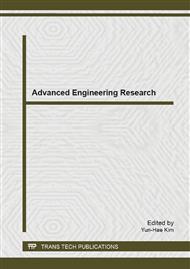[1]
Milkov, A.V.: Global estimates of hydrate-bound gas in marine sediments: how much is really out there. Earth-Science Reviews, Vol 66(3-4) (2004): 183–197.
DOI: 10.1016/j.earscirev.2003.11.002
Google Scholar
[2]
Grevemeyer, I. and Villinger, H.: Gas hydrate stability and the assessment of heat flow through continental margins. Geophysical Journal International, Vol 145(2001): 647–660.
DOI: 10.1046/j.0956-540x.2001.01404.x
Google Scholar
[3]
Shipley, T.H., Houston, M.H., Buller, R.T., et al.: Seismic evidence for widespread possible gas hydrate horizons on continental slopes and margins. American Association of Petroleum Geologists Bulletin, Vol 63(1979): 2204-2213.
DOI: 10.1306/2f91890a-16ce-11d7-8645000102c1865d
Google Scholar
[4]
Ganguly, N., Spence, G.D., Chapman, N.R., et al.: Heat flow variations from bottom simulating reflectors on the Cascadia margin. Marine Geology, Vol 164(2000): 53-68.
DOI: 10.1016/s0025-3227(99)00126-7
Google Scholar
[5]
Kaul, N., Rosenberger, A. and Villinger, H.: Comparison of measured and BSR-derived heat flow values, Makran accretionary prism, Pakistan. Marine Geology, Vol 164(2000): 37-51.
DOI: 10.1016/s0025-3227(99)00125-5
Google Scholar
[6]
Riedel, M., Novosel, I., Spence, G.D., et al.: Geophysical and geochemical signatures associated with gas hydrate-related venting in the northern Cascadia margin. Geological Society of American Bulletin, Vol 118(2006): 23–38.
DOI: 10.1130/b25720.1
Google Scholar
[7]
Shankar, U. and Riedel, M.: Seismic and heat flow constraints from the gas hydrate system in the Krishna - Godavari Basin, India. Marine geology, Vol 276(2010): 1-13.
DOI: 10.1016/j.margeo.2010.06.006
Google Scholar
[8]
Shyu, C.T., Chen, Y.J., Chiang, S.T., et al.: Heat flow measurements over bottom simulating reflectors, offshore southwestern Taiwan. Terrestrial Atmospheric and Ocean Sciences, Vol 17(2006): 845-869.
DOI: 10.3319/tao.2006.17.4.845(gh)
Google Scholar
[9]
Sager, W.W., Lee, C.S., MacDonald, I.R., et al.: High-frequency near-bottom acoustic reflection signatures of hydrocarbon seeps on the northern Gulf of Mexico continental slope. Geo-Marine Letters, Vol 18(1999): 267–276.
DOI: 10.1007/s003670050079
Google Scholar
[10]
Bredehoeft, J. D. and Papadopoulos, I.: Rates of vertical groundwater movement estimated form the earth's thermal profiles. Water Resources Research, Vol 1(2) (1965): 325-328.
DOI: 10.1029/wr001i002p00325
Google Scholar
[11]
Pautot, G., Rangin, C., et al.: Spreading direction in the central South China Sea. Nature, Vol 321(1986): 150-154.
DOI: 10.1038/321150a0
Google Scholar
[12]
Yao, B.: The gas hydrate in the South China Sea. Tropic Oceanology, Vol 20(2) (2001): 20-28.
Google Scholar
[13]
Yao, Bo Chu and Wu, Neng You: Gas hydrate, a future energy resource. Earth Frontiers, Vol 12(1) (2005): 225-233.
Google Scholar
[14]
Davis, E.E. and Hyndman, R. D.: Rates of fluid expulsion across the northern Cascadia accretionary prism: constraints from new heat flow and multichannel seismic reflection data. . Journal of Geophysical Research, Vol 95(1990): 8869-8889.
DOI: 10.1029/jb095ib06p08869
Google Scholar
[15]
Wang, H., Liang, J., Gong, Y., et al.: Estimation of the heat flow in the northern of the South China Sea based on the seismic data of gas hydrate. Geosciences, Vol 19(1) (2005): 67-73.
Google Scholar
[16]
Dickens, G. R. and Quinbyhunt, M. S.: Methane Hydrate Stability in Seawater. Geophysical Research Letters, Vol 21(19) (1994): 2115-2118.
DOI: 10.1029/94gl01858
Google Scholar


